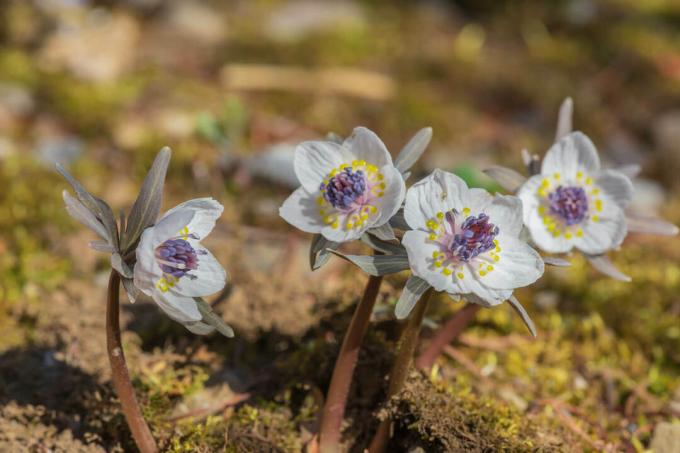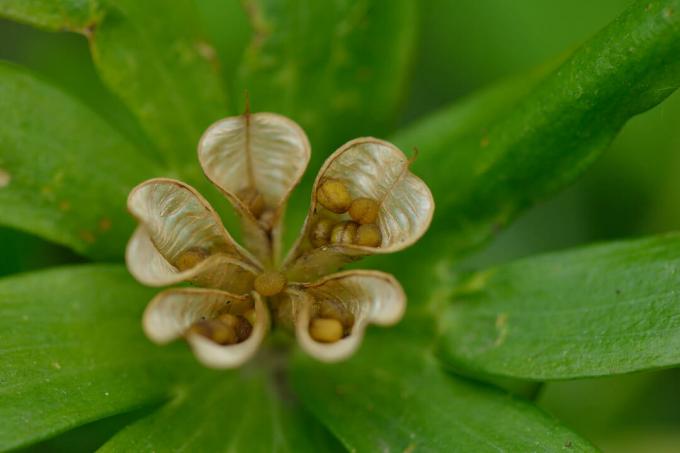Winterling is one of the first spring flowers to appear in our gardens, parks and forests at the end of winter. Here you can find out everything about planting, caring for and propagating the early bloomer.

With their bright yellow flowers, winterlings bring some color back into the wintry garden and herald the beginning of spring phenological calendar a. We give tips on choosing a variety, planting and caring for winterlings.
contents
- Winterling: flowering time and properties
- The most beautiful Winterling varieties and species
-
Planting winterlings: location, timing and procedure
- Sowing winterlings
- Plant winterling tubers
- The right care
- multiply winterlings
- Are winterlings poisonous?
Winterling: flowering time and properties
The Winterling (Eranthis), sometimes also called fieldwort or garlic flower, is a species within the buttercup family (Ranunculaceae). The plants originally come from southern Europe, but have been naturalized with us for many years and are not invasive.

The bulbous rhizome drives green to bronze-colored stalks through the snow cover in early spring, usually between February and March. At the end there is a yellow or white flower with mostly six petals, which apparently sit on a deeply divided bract that encompasses the stem. This leaf wreath is not a calyx, but a leaf. More single leaves appear after the winterling has bloomed. Following pollination, the reproductive species produce four to eight beaked follicles, each of which is up to 1.5 centimeters in size and contains several seeds. They ripen and open from May. When it rains, the seeds are thrown out and spread by the impact of water droplets. In summer, the winterling feeds on the green parts of the plant and survives in the ground with the help of its storage tuber until the next spring.
Are winterlings bee friendly? Winterlings are bee-friendly because they are usually the first food of the year for bees and bumblebees. The intense, reminiscent of pansies (viola) reminiscent, sweet and fresh scent as well as the good pollen and nectar content attract numerous insects to the flowers on a warm spring day.

The most beautiful Winterling varieties and species
- little winterling (Eranthis hyemalis): Winter agaric from southern Europe and most common species in our gardens. The species grows to a height of 5 to 10 cm, flowers as early as February and has light yellow flowers with a tightly fitting bract. the Eranthis- Variety 'Schwefelglanz' shows strikingly light, ocher flowers. 'Noel Ayres', on the other hand, shows semi-double, sterile flowers. The 'Winter Magic' variety starts flowering as early as December or January and is one of the earliest varieties.
- Turkish Winterling (Eranthis cilicica): Approximately 5 to 10 cm high species with a finely structured wreath of leaves. The stem is bronze, the yellow flowers appear from March and are larger than those of Eranthis hyemalis.
- hybrid winterling (Eranthis x tubergenii): Sterile hybrid off E hyemalis and E cilicica, which can only be multiplied by division. The Winterling varieties 'Guinea Gold' and 'Glory' have bronze-colored leaves and lemon to sun-yellow flowers.
- White-flowered Winterling: Japanese Winterling (Eranthis pinnatifida) is a 5 to 15 cm tall, endemic white winterling species from Japan with white flowers and blue-violet stamens. The leaves are long-lobed and deeply lobed. The Siberian Winterling (Eranthis sibirica) is native to eastern Siberia. The 10 to 15 cm long flower stalks bear large, white flowers with light green stigmas. Unfortunately, both white-flowered species are rarely for sale.

Planting winterlings: location, timing and procedure
Winterlings are typical forest and wood edge residents, they feel comfortable under later sprouting shrubs and deciduous trees. Seed-forming winterlings can quickly spread over a wide area and thus form a carpet of flowers over the years. The ideal location for winterlings is sunny to semi-shady on fresh, permeable and moderately nutrient-rich soil. Slightly calcareous, not too heavy clay soils are ideal because they store enough water for the winterlings.
Winterlings in the pot need a good water supply, as the substrate dries out faster. The pots should spend the winter cool but protected from frost. Towards the end of winter, when the first shoots appear, they are put outside again. Our Plantura organic potting soil is very suitable for planting because it has a loose structure and already contains essential nutrients. In order to increase the water storage capacity, it makes sense to mix in bentonite.
Sowing winterlings
The seeds of winterlings are cold germs, they need a longer period of cold with temperatures between -4 and +4 °C to germinate. Therefore, sow winterlings in an open spot in the garden immediately after the seeds have ripened in summer. The sowing depth is 0.5 to 1 cm. In the coming winter, the seed dormancy will be broken by the cold and the first seedlings will appear as early as January. The sown winterlings flower for the first time after about three years. Particularly Eranthis hyemalis and Eranthiscilicica However, they will self-seed successfully and reproduce all by themselves.
Tip: A snow cover in winter also softens the seed coat and thus accelerates germination.
Plant winterling tubers
Winterlings prefer planting in groups of 3 to 20 plants. With a planting distance of 5 to 20 cm, a loose underplanting with a natural character is created, which spreads itself through sowing. Sterile varieties should be planted close together to 400 bulbs per m² to get a dense carpet of flowers, as they do not self-seed.
The small, hard bulbs of the winter agaric are planted between September and October. Pre-soaking the tubers in warm water for a few hours before planting can encourage growth. The planting depth for winterlings is about 3 to 5 cm, the planting distance is about 5 to 20 cm. The hardy outlasting organs remain in the bed all year round and do not have to be dug up.

The right care
Winter agarics are extremely easy to care for, as they survive most of the gardening year in the ground. They don't need to be pruned and you should definitely not chop between the plants as the rhizomes can be damaged. If the spring is dry and warm, the winterlings should be watered regularly. The nutrient requirement of the easy-care early bloomers is low. In poorer soils, some compost or potting soil can be worked into the soil before planting. After a few years, however, the nutrient supply of the undemanding winterlings can be exhausted on light, sandy soils. This can first be recognized by the reduced willingness to flower, and in the case of more acute nutrient deficiencies also by the premature yellowing of the leaves. A predominantly organic long-term fertilizer, like ours Plantura organic flower fertilizer, can be distributed loosely over the crop from March if the soil is frost-free or used when repotting winterlings in pots. After application, it is optimally watered. The granulate slowly and gently releases the nutrients it contains over weeks and months.
multiply winterlings
Depending on the species, winterlings can be propagated by seed or vegetatively by dividing the bulbous rhizome. For many varieties, namely the sterile ones, the latter method is the only option. Immediately after flowering, the clumps are divided and moved with a spade. You can also transplant the hard, small tubers individually in autumn from September. Seeds of winterlings can be harvested and dried between April and May together with the follicles.

Are winterlings poisonous?
Like all buttercup plants, the winter cultivar is highly poisonous. Children and greedy pets should be kept away from early bloomers. Both the above-ground parts of the plant and the underground rhizomes contain cardioactive glycosides. Typical symptoms of poisoning are nausea, vomiting and cardiac arrhythmias up to and including cardiac arrest.
Show after winter early bloomers the first splashes of color after snow and frost. We give you an overview of the 15 most beautiful early flowering species.



